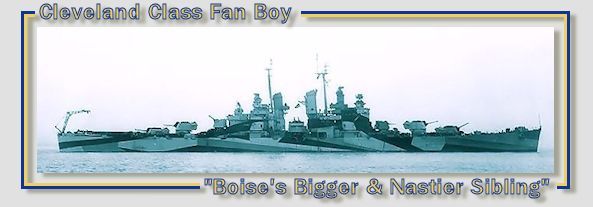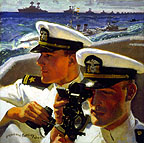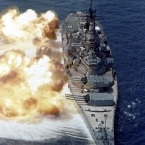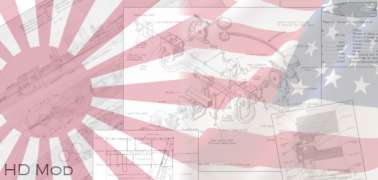el cid again
Posts: 16922
Joined: 10/10/2005
Status: offline

|
The data below indicate the gun should be rated at 150 accuracy - midway between a ROF of 10 and 20 - its practical range.
QF 3.7-inch AA gun
From Wikipedia, the free encyclopedia
Jump to: navigation, search
QF 3.7-in Heavy Anti-aircraft Gun
3,7in AA Gun-Aberdeen.00051hw5.jpg
3.7 inch Anti-Aircraft Gun on display at the U.S. Army Ordnance Museum in Aberdeen, Maryland
Type
Anti-aircraft gun
Place of origin
United Kingdom
Service history
In service
1937–1959
Used by
UK and Commonwealth
Wars
World War II
Production history
Designer
Vickers[1]
Designed
1937
Produced
1937–1945
Number built
approx. 10 thousand[citation needed]
Specifications
Weight
20,541 lb (9,317 kg)
Length
4.96 m (16 ft 3 in)
Barrel length
4.7 m (15 ft 5 in) L/50
Crew
7
--------------------------------------------------------------------------------
Shell
28 lb (12.7 kg)
Calibre
3.7 inches (94 mm)
Carriage
Mobile and static versions
Elevation
-5 to +80
Traverse
360
Rate of fire
10/20 rpm
Muzzle velocity
Mk I - III: 2,670 ft/s (810 m/s) (new)
2,598 ft/s (792 m/s) (worn)[2]
Mk VI : 3,425 ft/s (1,044 m/s)[3]
Maximum range
Maximum horizontal: 18,800 m (61,679 ft)
Maximum slant: 12,000 m (39,370 ft)
Ceiling Mk I-II: 9,000 m (29,527 ft) Mk VI: 45,000 ft (13,716 m)
The 3.7-Inch QF AA was Britain's primary heavy anti-aircraft gun during World War II. It was roughly the equivalent of the German 88 mm FlaK and American 90mm, but with a slightly larger calibre of 94 mm. It was used throughout World War II in all theatres except the Eastern Front. The gun was produced in six major variants, two versions (mobile and fixed) and in considerable numbers. The Mk VI ordnance used only with a fixed mounting gave vastly increased performance. It remained in use after the war until AA guns were replaced by guided missiles, notably the English Electric Thunderbird, in the late 1950s.
Contents
[hide] 1 History 1.1 Background
1.2 QF 3.7
2 Description 2.1 Gun
2.2 Ammunition
3 Ordnance Variants 3.1 Mk I
3.2 Mk II
3.3 Mk III
3.4 Mk IV
3.5 Mk V
3.6 Mark VI
4 Performance
5 Field and Anti-tank
6 Operators
7 References
8 External links
History[edit]
Background[edit]
During World War I anti-aircraft guns and anti-aircraft gunnery developed rapidly. The British Army eventually adopted the QF 3 inch AA gun as the most commonly used type. Shortly before the end of the war a new QF 3.6 inch gun was accepted for service but the end of the war meant it did not enter production. After the war, all anti-aircraft guns except the 3 inch gun were scrapped.
However, the War had shown the possibilities and potential for air attack and lessons had been learned. The British had used AA guns in most theatres in daylight, as well as against night attacks at home. They had also formed an AA Experimental Section during the war and accumulated much data that was subjected to extensive analysis. After an immediate post war hiatus, the Army re-established peacetime anti-aircraft units in 1922. In 1925 the RAF established a new command, Air Defence of Great Britain, and the Royal Artillery's anti-aircraft units were placed under its command.
In 1924–5 the War Office published the two-volume Textbook of Anti-Aircraft Gunnery. It included five key recommendations for Heavy Anti-Aircraft (HAA) guns:
Shells of improved ballistic shape with HE fillings and mechanical time fuzes.
Higher rates of fire assisted by automation.
Height finding by long-base optical rangefinders.
Centralised control of fire on each gun position, directed by tachymetric instruments which incorporated the facility to apply corrections of the moment for meteorological and wear factors.
More accurate sound-location for the direction of searchlights and to provide plots for barrage fire.
Two assumptions underpinned the British approach to HAA fire. First, aimed fire was the primary method and this was enabled by predicting gun data from visually tracking the target with continuous height and range input. Second, that the target would maintain a steady course, speed and height. HAA was to engage targets up to 24,000 feet. Mechanical, as opposed to igniferous, time fuzes were required because the speed of powder burning varied with height so fuze length was not a simple function of time of flight. Automated fire ensured a constant rate of fire that made it easier to predict where each shell should be individually aimed.[4]
During the 1920s Vickers developed the predictor, an electro-mechanical computer that took height and range data from an optical rangefinder, applied corrections for non-standard conditions and was used by its operators to visually track a target, its output predicted firing data and fuze setting via the "mag-slip" electrical induction system to dials on each gun in a battery, the gun layers moved the gun to match pointers on the dials. The 3 inch AA guns were modified accordingly.[4]
QF 3.7[edit]
In 1928 the general characteristics for a new HAA gun were agreed on; a bore of 3.7 inches (94 mm) firing 25 pounds (11 kg) shells with a ceiling of 28,000 feet (8,500 m). However, finance was very tight and no action was taken until 1930s, when the specification was enhanced to a 28 pounds (13 kg) shell, 3,000 feet per second (910 m/s) muzzle velocity, a 35,000 feet (11,000 m) ceiling, a towed road speed of 25 miles per hour (40 km/h), maximum weight of 8 tons and an into action time of 15 minutes.
In 1934 Vickers Armstrong produced a mock-up and proceeded to develop prototypes of the weapon, which was selected and passed acceptance tests in 1936.[5][6] However, the weight specification was exceeded and the muzzle velocity not achieved. Furthermore, the initial mechanical time fuze, No 206, was still some years from production so the igniferous No 199 had to be used, and its lesser running time limited the effective ceiling. Gun production started the following year.
On 1 January 1938 the British air defences had only 180 anti-aircraft guns larger than 50 mm, and most of these were the older 3 inch guns. This number increased to 341 by the September 1938 (Munich Crisis), to 540 in September 1939 (declaration of war), and to 1,140 during the Battle of Britain. Production continued until 1945, averaging 228 guns per month throughout the period. Guns were also manufactured in Australia.
Being a high velocity gun, with a single charge and firing substantial quantities of ammunition, meant that barrel life could be short. By the end of 1940 the barrel situation was becoming critical. Some of the substantial numbers of spare barrels required were produced in Canada.
In British service the gun replaced the 3 inch AA gun in Heavy Anti-Aircraft (HAA) Batteries of the Royal Artillery, almost always in Heavy Anti Aircraft Regiments, which were usually in an Anti-Aircraft Brigade. Each regiment usually had three batteries, each of 8 guns in two troops. A total of 212 of these HAA Regiments, Royal Artillery, and two each of the Royal Marines and Royal Malta Artillery were eventually formed. Other World War II users were India (about 14 regiments), Canada (2 or 3 regiments), East & West Africa (5 regiments), Australia (equivalent of about 13 regiments).
|
 Printable Version
Printable Version





















 New Messages
New Messages No New Messages
No New Messages Hot Topic w/ New Messages
Hot Topic w/ New Messages Hot Topic w/o New Messages
Hot Topic w/o New Messages Locked w/ New Messages
Locked w/ New Messages Locked w/o New Messages
Locked w/o New Messages Post New Thread
Post New Thread